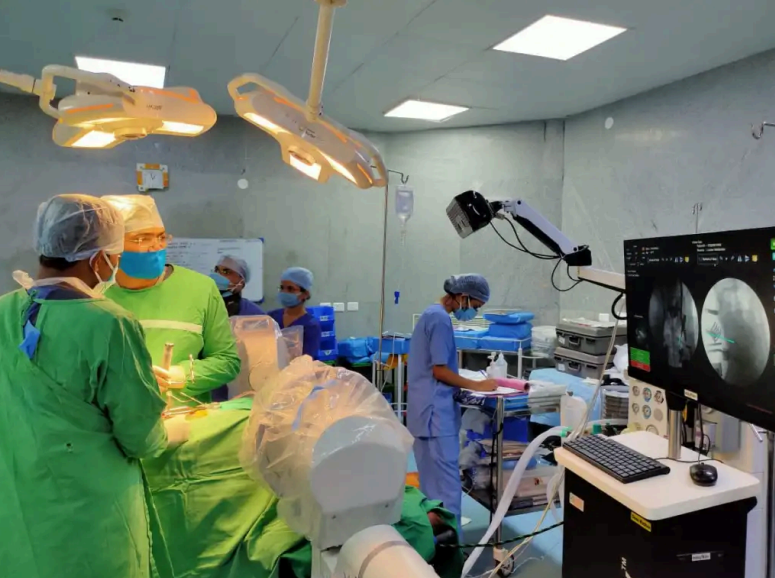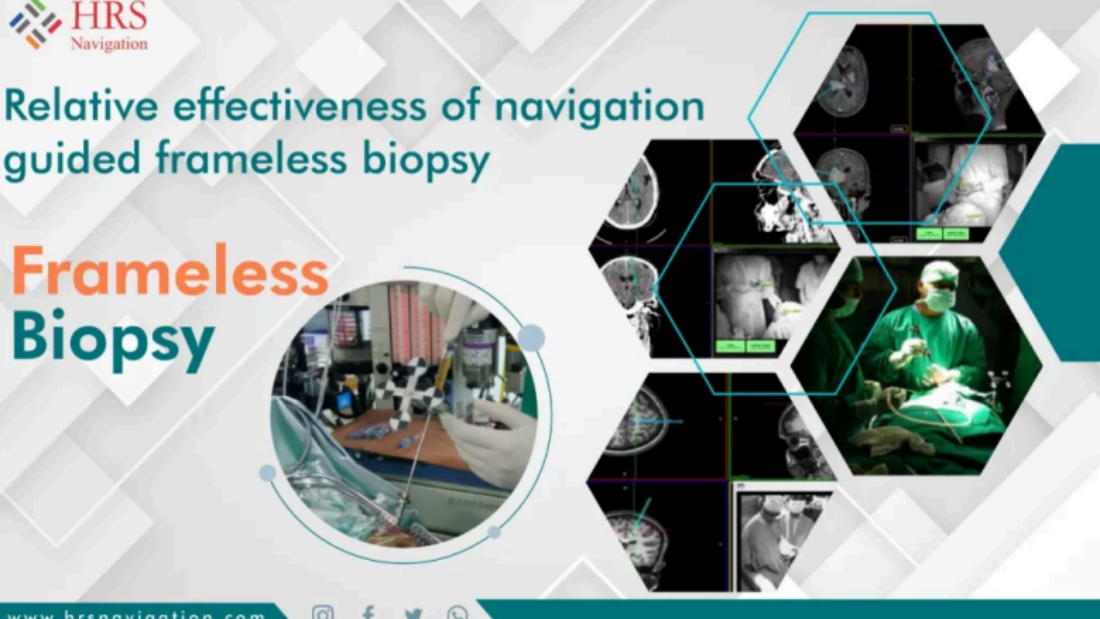Over the last few decades, scientific advancements and innovations have led to appreciable changes in our lifestyle. Substantial developments and technological evolution in the healthcare industry have made medical treatments more accessible and affordable. Medical tourism is being promoted by the government and stimulated by the corporate boom in medical care. As a result, India is fast emerging as a medical tourism hub for patients from across the world. International tourists coming to India for medical treatment demand high-quality care and world-class devices/equipment. High-end medical technology products are largely imported to India constituting about 75% of the Indian medical technology market.
The complexity in surgeries faced by surgeons declined as new innovations were evolved; such evolution’s in the computer-assisted technologies effectuated navigation based surgeries around the globe. However navigation in surgery still remains a fantasy for surgeons working in low budget hospitals and patients demanding affordable surgeries. This drawback is due to the high pricing and bulky structuring of the imported navigation systems specifically built for foreign infrastructure.
Understanding Surgical Navigation Technology
Surgical navigation represents a paradigm shift in modern surgery, utilizing real-time imaging and computer-guided systems to enhance surgical precision. These systems have become indispensable tools for surgeons operating in complex anatomical regions where millimeter-level accuracy can mean the difference between success and complications.
The technology integrates pre-operative imaging data with intraoperative guidance, enabling surgeons to visualize critical structures and navigate complex anatomical pathways with unprecedented accuracy. This advancement has particular significance in India, where the development of the first indigenous navigation system has made this technology more accessible and affordable.
Cranial Navigation: Transforming Neurosurgical Outcomes
Cranial navigation has revolutionized neurosurgery by providing surgeons with real-time guidance during the most delicate brain procedures. This technology addresses critical challenges in neurosurgical interventions, particularly when dealing with small, deep-seated brain lesions and tumors located in functionally important areas.
Benefits of Cranial Navigation Systems
Modern cranial navigation systems offer several key advantages:
- Enhanced Precision: Achieving accuracy within 1-2 millimeters, crucial for brain tumor resections.
- Improved Safety: Minimizing trauma to healthy brain tissue and reducing surgical risks
- Better Outcomes: Studies show patients operated with neuronavigation have longer survival rates (median 13.4 vs. 11.1 months)
- Reduced Invasiveness: Enabling smaller craniotomies while maintaining surgical effectiveness
Leading hospitals across India, including IBS Hospital and Fortis Healthcare, have successfully integrated cranial navigation systems, significantly improving patient outcomes in complex neurosurgical procedures.
Spine Navigation: Advancing Orthopedic and Spinal Surgery
Spine navigation has emerged as a game-changing technology in orthopedic and spinal surgery, particularly in minimally invasive spine surgery (MIS) procedures. The integration of computer-assisted navigation in spine surgery has addressed longstanding challenges in pedicle screw placement and spinal instrumentation.
Applications and Benefits
Spine navigation systems provide:
- Accurate Pedicle Screw Placement: Reducing the risk of screw malposition and associated complications
- Minimally Invasive Procedures: Enabling smaller incisions and faster recovery times
- Real-time Imaging: Providing continuous intraoperative guidance for complex spinal reconstructions
- Reduced Radiation Exposure: Minimizing X-ray usage during surgery
Indian hospitals like Artemis Hospitals and Ganga Hospital have pioneered the use of spine navigation systems, offering advanced minimally invasive procedures that significantly reduce surgical complications and improve patient outcomes.
ENT Navigation: Precision in Sinus and Nasal Surgery
ENT navigation has transformed otolaryngological procedures, particularly in endoscopic sinus surgery and complex nasal reconstructions. India’s experience with ENT navigation dates back to early adoption phases, with documented accuracy within 2 millimeters being achieved in clinical practice.
Key Applications in ENT Surgery
ENT navigation systems excel in:
- Endoscopic Sinus Surgery: Providing real-time guidance for navigating complex sinus anatomy
- Functional Nasal Surgery: Enhancing precision in procedures that improve both form and function
- Complex Reconstructions: Supporting intricate procedures that require detailed anatomical knowledge
- Revision Surgeries: Assisting in challenging cases where normal anatomy may be altered
The integration of image-guided surgery in ENT procedures has shown significant benefits, with studies demonstrating improved accuracy and reduced complications in endoscopic sinus surgeries performed across Indian medical centers.
The Indigenous Innovation: Made in India Solutions
Addressing the challenges of high costs and bulky imported systems, India has developed its first indigenous surgical navigation system. This breakthrough innovation features:
- Compact Design: Optimized for Indian hospital infrastructure
- Affordable Pricing: Making advanced navigation accessible to more healthcare facilities
- Reduced Consumables: Lower operational costs for sustained use
- Local Support: Comprehensive service and maintenance within India
This indigenous development represents a significant milestone in India’s journey toward self-reliance in advanced medical technology, making precision surgery accessible to a broader patient population.
Future Prospects and Technological Integration
The convergence of artificial intelligence, augmented reality, and surgical navigation promises even greater advancements. Emerging technologies include:
- Augmented Reality Navigation: Providing surgeons with enhanced visualization capabilities
- AI-Assisted Planning: Optimizing surgical approaches through machine learning algorithms
- Robotic Integration: Combining navigation systems with robotic surgical platforms
- Real-time Analytics: Providing immediate feedback on surgical performance and outcomes
Conclusion
Surgical navigation has fundamentally transformed modern healthcare delivery in India, establishing the country as a leader in precision medicine. The successful integration of cranial navigation, spine navigation, and ENT navigation systems across Indian hospitals demonstrates the nation’s commitment to providing world-class healthcare at affordable costs.
As India continues to develop indigenous solutions and expand access to advanced surgical technologies, patients worldwide increasingly recognize the country as their preferred destination for complex surgical procedures. The combination of skilled surgeons, cutting-edge technology, and cost-effective care positions India at the forefront of the global medical tourism revolution.
The future of surgical navigation in India looks exceptionally promising, with continued innovations expected to further enhance surgical precision, improve patient outcomes, and solidify the country’s position as a global healthcare hub. This technological evolution not only benefits patients but also elevates the standard of surgical care across the entire healthcare ecosystem.
Frequently Asked Questions
What is surgical navigation?
A technology that guides surgeons using real-time imaging for precise, safe, and minimally invasive procedures.
How does it help patients?
It improves accuracy, reduces surgical risks, speeds recovery, and ensures better outcomes for complex surgeries.
Where is it used?
In neurosurgery, spine, and ENT surgeries for precise tumor removal, screw placement, and sinus procedures.
What’s special about India’s system?
India’s indigenous navigation system is affordable, compact, and designed for local hospital needs.
What’s the future of this tech?
AI, AR, and robotics will make surgeries even more accurate, efficient, and data-driven in the future.












